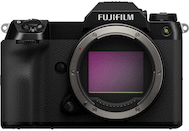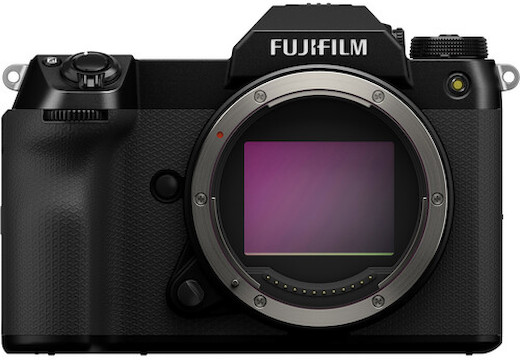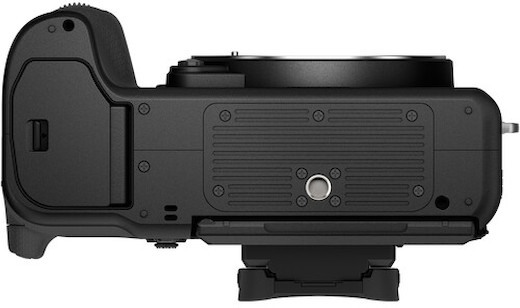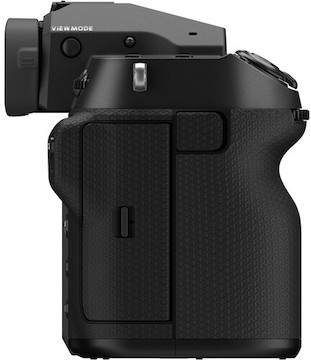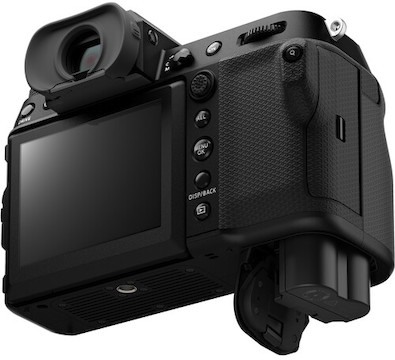The Fuji GFX 100S II Medium Format Mirrorless is a versatile, professional-grade, medium-format mirrorless camera, and a significant update to the original Fuji GFX 100S. Key features include:
New 102MP CMOS sensor and X-Processor 5
4K30 720 Mb/s internal video, 12-bit RAW out; F-Log2
Updated subject-recognition autofocus
Up to 8 stops of sensor-shift image stabilization
What’s Changed? The Fuji GFX 100S II Medium Format Mirrorless offers a few substantial updates to its predecessor. It boasts a more powerful image-stabilization system that’s rated for up to eight stops of correction, subject-recognition autofocus, 7 fps still shooting, pixel-shift high-res mode, enhanced video capture, an improved viewfinder, faster overall performance, and native camera-to-cloud uploading capabilities with Adobe’s Frame.io platform.
Newly Designed 102MP CMOS II Sensor. The GFX 100S II uses a newly developed 43.8 × 32.9mm CMOS sensor for superior sharpness, accuracy, and image quality in a variety of lighting conditions. You get a broad ISO 100-12,800 sensitivity range that can be extended to ISO 40-102,400 for photo and ISO 100-25,600 for video, while each pixel’s large size makes for efficient light gathering.
X-Processor 5 Imaging Processor. The GFX 100S II needs a versatile and powerful processor to handle all the data it captures, and the X-Processor 5 fits the bill. This processor works in tandem with the 102MP CMOS sensor to give you continuous shooting at up to 7 fps, and DCI and UHD 4K30 video capture. It also gives you a range of Film Simulation modes, including the new REALA ACE mode.
Multiple Aspect Ratios. You can adapt this camera to various aspect ratios, including 1:1, 3:2, 4:3 (default), 5:4, 7:6, 16:9, and 65:24.
Fuji G-Mount. The larger medium-format sensor requires lenses with a larger image circle, thus was born the G-mount. As it’s designed for mirrorless, the G-mount features a short flange back distance of just 26.7mm. Fuji X-mount lenses aren’t compatible with this medium-format camera.
UHD and DCI 4K Video Capture. The GFX 100S II’s combination of a large sensor and fast processor means that it can internally capture UHD and DCI 4K30p video at up to 4:2:2 10-bit with an improved 720 Mb/s data rate. It can also output Apple ProRes 422 footage to an external SSD via its USB-C port and a broad range of formats—including 12-bit ProRes RAW and Blackmagic RAW—to a Atomos or Blackmagic recorder via its HDMI port. You can simultaneously record external and internal video, and the included F-Log2 gamma setting provides a 13+ stop dynamic range that’ll make color editing easier in post.
Sensor-Shift Image Stabilization. The five-axis in-body sensor-shift image-stabilization system reduces the appearance of camera shake by up to eight stops when used with OIS-enabled lenses, which is crucial when you’re working without a tripod, at slower shutter speeds, or in difficult lighting conditions. That said, image stabilization works with any lens, including non-stabilized lenses.
Pixel-Shift Multishot Modes. The GFX 100S II includes the Pixel-Shift Multishot mode found in previous Fuji cameras, which takes 16 exposures in rapid succession, shifting the image sensor by half a pixel between each shot and then uses Fuji’s Pixel-Shift Combiner software to combine RAW images into a single, massive, and highly detailed 400MP image. It also features a new 4-image Pixel-Shift Multishot mode that cancels the Bayer filter by capturing red, green, and blue information for each pixel position and boosts tonal quality by combining four frames.
Updated Autofocus System. The updated on-sensor autofocus system uses 425 selectable points to cover almost the entire sensor area, and it’s sensitive down to -5.5 EV for working in truly low light. This focusing system uses a deep-learning backed AI-adaptive algorithm to offer improved tracking of a wide range of subject types. The Face and Eye Detection capabilities can account for features and accessories like glasses, masks, and hairlines, and the autofocus system can now recognize an even greater array of subjects, including cars, motorcycles, trains, planes, cats, dogs, birds, horses, and drones. Like its predecessor, the GFX 100S II has a dedicated joystick for intuitive AF-point selection. Face and Eye-Detection AF modes are available when you’re working in AF-C mode and when you’re recording video. When you’re using AF-C and Wide/Tracking AF, the camera will track your designated subject even if there are multiple potential subjects in frame.
Improved EVF and Tilting Touchscreen LCD. The fixed 5.76m-dot OLED electronic viewfinder features 0.84x magnification while offering 100% coverage. You also get a tilting 3.2-inch, 2.36m-dot rear touchscreen LCD for navigating menus, controlling image playback, shooting in live view, and selecting focus area. Finally, there’s a 1.8-inch status-display LCD on the camera’s top plate that lets you quickly verify shooting settings and exposure data.
Durable, Compact Build. The GFX 100S II features a weather- and dust-resistant build that lets it function in temperatures ranging from 14º to 104º Fahrenheit. There are dual SDHC / XC memory-card slots that support UHS-II memory, and the included rechargeable NP-W235 battery is rated for an estimated 530 shots per charge. The camera body retains the original GFX 100S’s lightweight, travel-friendly form. Integrated Bluetooth 4.2 low-energy and Wi-Fi 5 connectivity allow you to share images to a mobile device or use a mobile device to control the camera.
Native Frame.io Camera-to-Cloud Functionality. You can use this camera’s built-in Wi-Fi or Ethernet LAN connectivity to instantly upload your Apple ProRes proxy video files and JPEG, HEIF, or RAW stills to the Frame.io cloud platform with full TPN+ and SOC 2 Type 2 compliant encryption. Uploading your videos and shots to the cloud from your shooting location lets you speed up your workflow with real-time access and editing from anywhere. For more information, please click here.
